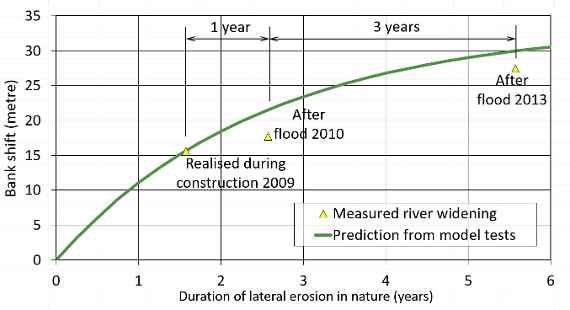Photo of the left bank of the Salzach in the area of the self-dynamic widening in June 2016 (three years after a 100-year flood).
In the project section, the Salzach has deepened considerably over many decades. In order to raise the riverbed again, ramps were planned. Upstream of the ramp bedload can settle. Thus, it is not only possible to raise the riverbed, but also to better connect the groundwater and the floodplains accompanying the river. The sedimentation upstream of the ramp temporarily creates a bedload deficit downstream. This deficit is compensated with bedload from the river widening.
The main innovation in the planning was that the river should widen itself as much as possible. In 2001, a model test on a scale of 1:50 was carried out to investigate how this self-dynamic widening can work.
After construction of the ramp and removal of the bank protections for the widening in 2009, two large floods were observed in 2010 and 2013. The first event corresponded to an annuality of about 30 and the second had an annuality of more than 100.
The comparison between the prognosis based on the model tests and the measurements in nature show that self-dynamic widening can be predicted well depending on the runoff event. The quality of the forecast depends strongly on the quality of the available data. The actual rate of widening, however, depends on the unpredictable hydrology of the years after removal of the bank protections.
The graph shows the comparison between the predicted widening from the model tests and the actually measured widening of the river.

